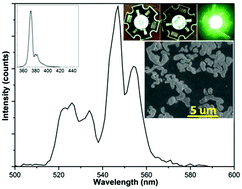Synthesis, optical properties and application of Y7O6F9:Er3+ for sensing the chip temperature of a light emitting diode
Abstract
Submicron-sized Er3+ doped Y7O6F9 phosphors were synthesized via the precipitation method and a subsequent annealing process. The influence of the Er3+ doping concentrations and the heating temperature on the luminescence of Y7O6F9:Er3+ was investigated under the excitation of the Er3+ 4G11/2 level at 378 nm. Upon raising the Er3+ doping concentration, both the intensity and lifetime of the Er3+ green emission at 547 nm originating from 4S3/2 → 4I15/2 decrease, which is proved to be caused by energy transfer via cross relaxation between two neighboring Er3+ ions. The thermal sensing properties of Y7O6F9:Er3+ were evaluated using the temperature dependent intensity ratio between the 2H11/2–4I15/2 and 4S3/2–4I15/2 transitions of Er3+ under 378 nm excitation. The experimental results show that the thermal sensitivity decreased with an increase in the Er3+ doping content, which is caused by the increased energy transfer probability among Er3+. The increased energy transfer of Er3+ reduces the thermalized population of Er3+ in the 2H11/2 levels, which in turn decreases the thermal sensitivity. The applicability of Er3+ doped Y7O6F9 as a thermal sensor was demonstrated by measuring the chip temperature of a 1 W InGaN type near-ultraviolet light emitting diode (n-UV LED).



 Please wait while we load your content...
Please wait while we load your content...